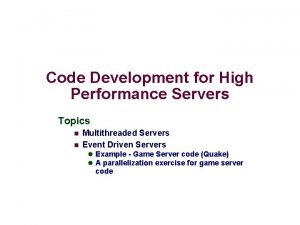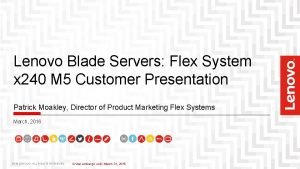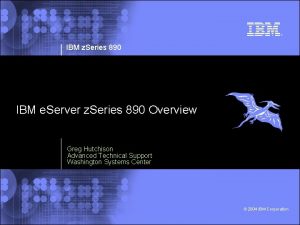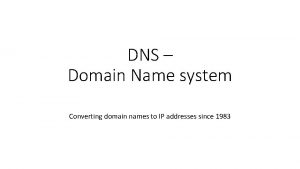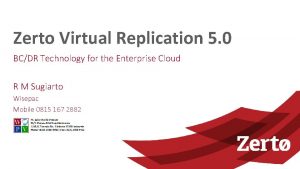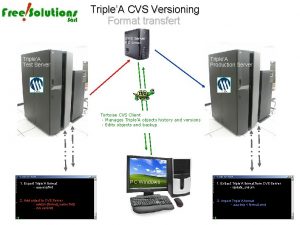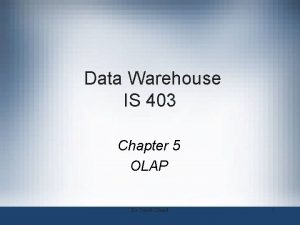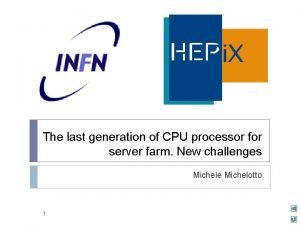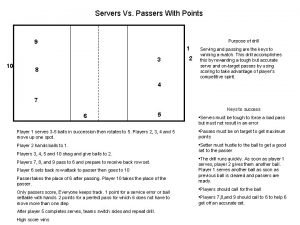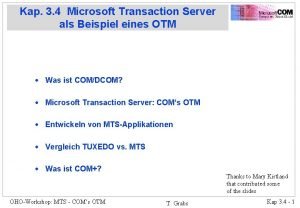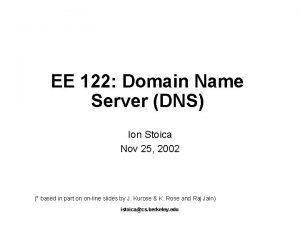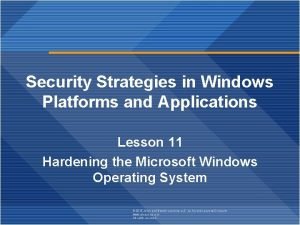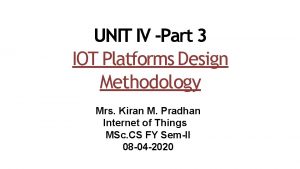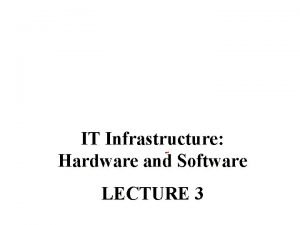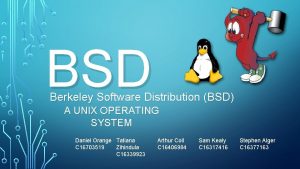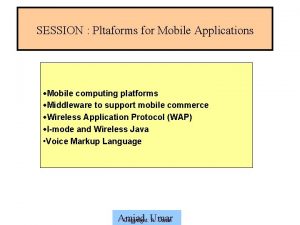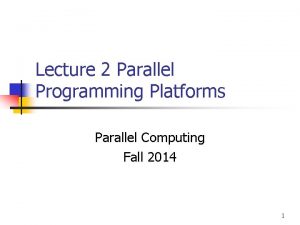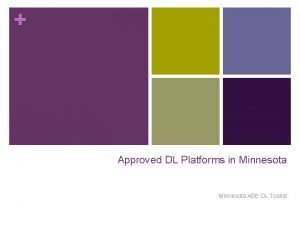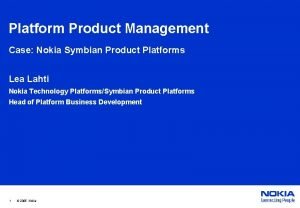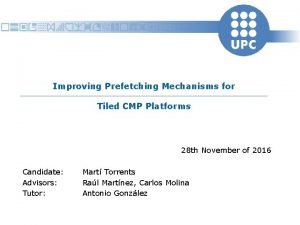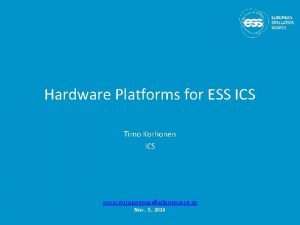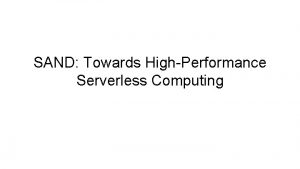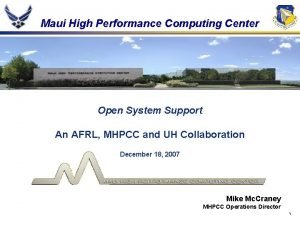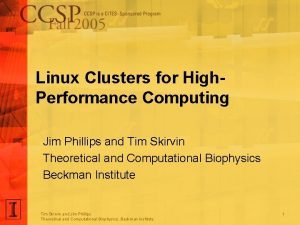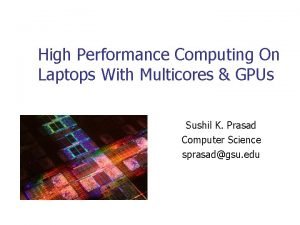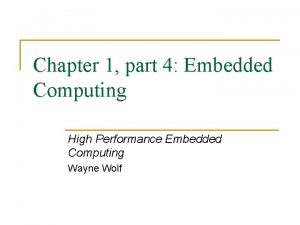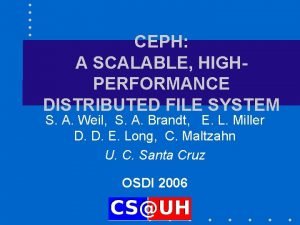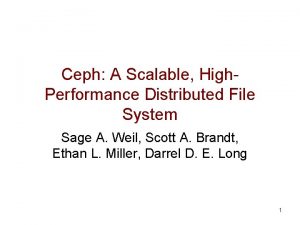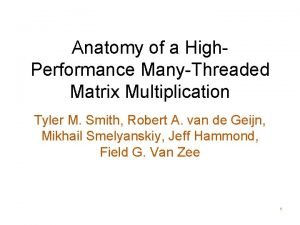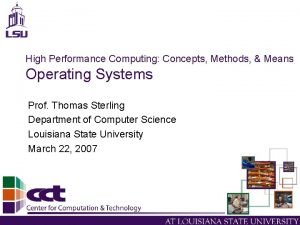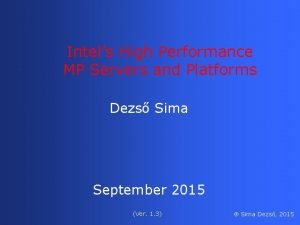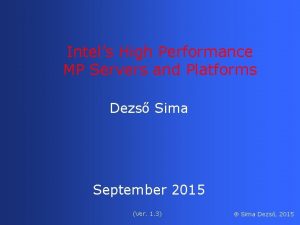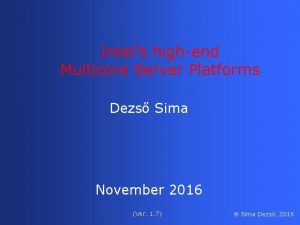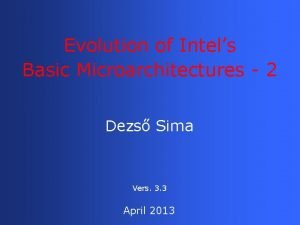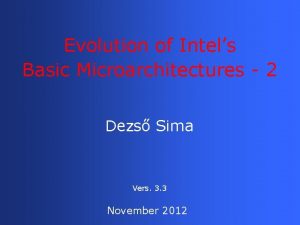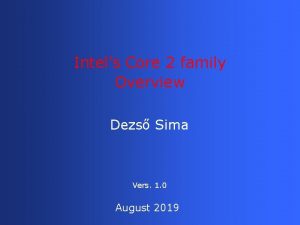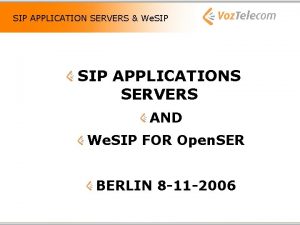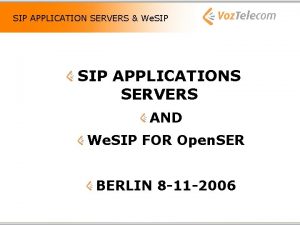Intels High Performance MP Servers and Platforms Dezs






























































































![4. Example 2: . The Purley platform (2) Positioning of the Purley platform [112] 4. Example 2: . The Purley platform (2) Positioning of the Purley platform [112]](https://slidetodoc.com/presentation_image_h/770a414e8e12176a53fc050d3964b21f/image-95.jpg)



- Slides: 98

Intel’s High Performance MP Servers and Platforms Dezső Sima September 2015 (Ver. 1. 3) Sima Dezső, 2015

Intel’s high performance MP platforms • 1. Introduction to Intel’ s high performance multicore MP servers and platforms • 2. Evolution of Intel’s high performance multicore MP server platforms • 3. Example 1: The Brickland platform • 4. Example 2: The Purley platform • 5. References

1. Introduction to Intel’s high performance MP servers and platforms • 1. 1 The worldwide 4 S (4 Socket) server market • 1. 2 The platform concept • 1. 3 Server platforms classified according to the number of processors supported • 1. 4 Multiprocessor server platforms classified according to their memory architecture • 1. 5 Platforms classified according to the number of chips constituting the chipset • 1. 6 Naming scheme of Intel’s servers • 1. 7 Overview of Intel’s high performance multicore MP servers and platforms

1. 1 The worldwide 4 S (4 Socket) server market

1. 1 The worldwide 4 S (4 Socket) server market (1) 1. Introduction to Intel’s high performance multicore MP servers and platforms 1. 1 The worldwide 4 S (4 Socket) server market [52]

1. 2 The platform concept

1. 2 The platform concept (2) Example 1: A simple traditional DC DP (2 S) server platform (2007) Core 2 (2 C) 1066 MT/s FSB 7200 ESI 631 x. ESB/ 632 x. ESB IOH FB-DIMM w/DDR 2 -533

1. 2 The platform concept (3) Example 2: A recent 4 S platform (The Brickland 4 S server platform including Haswell-EX processors (2015) 2 x 4 SMI 2 channels SMB PCIe 3. 0 Xeon E 7 -4800 v 3 (Haswell-EX) 32 Haswell-EX 14 C SMB 32 QPI 1. 1 SMB PCIe 3. 0 2 x 4 SMI 2 channels Haswell-EX 14 C SMB SMB QPI 1. 1 SMB SMB SMB Haswell--EX 14 C 32 PCIe 3. 0 SMB QPI 1. 1 DMI 2 4 x. PCIe 2 C 602 J PCH (Patsburg J) SMB Haswell-EX 14 C SMB 32 PCIe 3. 0 ME QPI 1. 1: Up to 9. 6 GT/s ME: Management Engine Up to DDR 3 -1600 in both performance and lockstep modes and up to DDR 4 -1866 in lockstep mode SMI 2: Scalable Memory Interface 2 (Parallel 64 -bit VMSE data link between the processor and the SMB) SMB: Scalable Memory Buffer (C 112/C 114: Jordan Creek 2) (Performs conversion between the parallel SMI 2 and the parallel DDR 3/DDR 4 DIMM interfaces) C 112: 2 DIMMs/channel C 114: 3 DIMMs/channel

1. 2 The platform concept (5) Example for compatibility of platform components (The Boxboro-EX platform 2010/2011) Xeon E 7 -4800 / (Westmere-EX) 10 C Xeon 7500 (Nehalem-EX) (Becton) 8 C SMB SMB Nehalem-EX 8 C Westmere-EX 10 C QPI SMB SMB QPI QPI SMB Nehalem-EX 8 C Westmere-EX 10 C SMB SMB Nehalem-EX 8 C Westmere-EX 10 C QPI 7500 IOH 4 x QPI up to 6. 4 GT/s 2 DIMMs/memory channel SMB QPI 2 x 4 SMI channels Nehalem-EX: up to DDR 3 -1067 Westmere-EX: up to DDR 3 -1333 SMB ESI ICH 10 ME 36 PCIe 2. 0 2 x 4 SMI channels SMI: Scalable Memory Interface (Serial link between the processor and the SMB) SMB: Scalable Memory Buffer (Performs conversion between the serial SMI and the parallel DDR 3 DIMM interfaces) ME: Management Engine Figure: The Boxboro-EX MP server platform supporting Nehalem-EX/Westmer-EX server processor

1. 3 Server platforms classified according to the number of processors supported

1. 3 Server platforms classified according to the number of processors supported (1) 1. 3 Server platforms classified according to the number of processors supported Server platforms Uniprocessor server platforms (UP-server platforms) 1 -processor server platforms (1 -socket server platforms) Multiprocessor server platforms Server platforms supporting more than one processor (Multi-socket server platforms) DP (2 S) server platforms 2 - processor server platforms (2 -socket server platforms) MP (4 S) server platforms Platforms for more than four servers 4 -processor server platforms (Server platforms for (4 -socket server platforms) more than four sockets)

1. 4 Multiprocessor server platforms classified according to their memory architecture

1. 4 Multiprocessor server platforms classified according to their memory arch. (1) 1. 4 Multiprocessor server platforms classified according to their memory architecture (1) Multiprocessor server platforms classified according to their memory architecture SMPs (Symmetrical Multi. Processor) NUMAs Multiprocessors (Multi socket system) with Uniform Memory Access (UMA) Multiprocessors (Multi socket system) with Non-Uniform Memory Access All processors access main memory by the same mechanism, (e. g. by individual FSBs and an MCH). A particular part of the main memory can be accessed by each processor locally, other parts remotely. Typical examples Processor QPI QPI FSB MCH E. g. DDR 3 -1333 IOH 1 E. g. DDR 2 -533 ESI ICH 1 ICH: I/O hub ESI: Enterprise System Interface

1. 4 Multiprocessor server platforms classified according to their memory arch. (2) Main features of SMP-type and NUMA-type server platforms Multiprocessor server platforms classified according to their memory architecture SMPs (Symmetrical Multi. Processor) • All processors share the same memory space and all processors access memory by the same access mechanism, (e. g. by the same FSB or by individual FSBs and an MCH. • Consequently, all processors access memory basically with the same latency. NUMAs • All processors share the same memory space, but each processor is allocated a particular part of the memory space, called the local memory space, whereas the rest is considered as the remote memory spaces. • The local part of the main memory can be accessed by each processor immediately, e. g. via their private on-die memory controller, whereas the remote parts of the main memory will be accessed via the processor owing the requested memory space. • Consequently, processors access their local memory space in significantly shorter latency than memory spaces remote to them.

1. 4 Multiprocessor server platforms classified according to their memory arch. (3) Example of measured read latencies of uncached data [73] Read latencies depend on whether referenced data is kept in the own or remote main memory space. a) Read latency when referenced data is kept in the own memory space Read latency: 65. 1 ns (190 cycles)

1. 4 Multiprocessor server platforms classified according to their memory arch. (4) b) Read latency when referenced data is kept in the remote memory space [73] Read latency: 106 ns (~310 cycles) Read latency is increased now by the inter-processor access penalty of 41 ns in this case.

1. 5 Platforms classified according to the number of chips constituting the chipset

1. 5 Platforms classified according to the number of chips constituting the chipset (1) 1. 5 Classification of platforms according to the number of chips constituting the chipset Implementation of platforms classified according to the number of chips constituting the chipset Three-chip implementation Two-chip implementation The system architecture consists basically of three chip types (processors/MCH/ICH) The system architecture consists basically of two chip types (processors/PCH) Truland platform (2005/2006) Caneland platform (2007/2008) Boxboro-EX platform (2010/2011) Brickland platform (2014/2015) Purley platform (2017? )

1. 5 Platforms classified according to the number of chips constituting the chipset (2) Example of a 3 -chip platform: The Boxboro-EX 4 S server platform supporting Nehalem-EX/Westmere-EX processors (2010/2011) Xeon 7500 (Nehalem-EX) (Becton) 8 C / Xeon E 7 -4800 (Westmere-EX) 10 C SMB SMB Nehalem-EX 8 C Westmere-EX 10 C QPI SMB SMB QPI QPI SMB Nehalem-EX 8 C Westmere-EX 10 C SMB SMB Nehalem-EX 8 C Westmere-EX 10 C QPI 7500 IOH 4 x QPI up to 6. 4 GT/s 2 DIMMs/memory channel SMB QPI 2 x 4 SMI channels Nehalem-EX: up to DDR 3 -1067 Westmere-EX: up to DDR 3 -1333 SMB ESI ICH 10 ME 36 PCIe 2. 0 2 x 4 SMI channels SMI: Scalable Memory Interface (Serial link between the processor and the SMB) SMB: Scalable Memory Buffer (Performs conversion between the serial SMI and the parallel DDR 3 DIMM interfaces) ME: Management Engine Nehalem-EX aimed Boxboro-EX MP server platform (for up to 10 C)

1. 5 Platforms classified according to the number of chips constituting the chipset (3) Example of a 2 -chip platform: The Brickland-EX 4 S server platform supporting Ivy Bridge-EX/Haswell-EX processors 2 x 4 SMI 2 channels SMB PCIe 3. 0 Xeon E 7 -4800 v 3 (Haswell-EX) 32 Haswell-EX 18 C SMB 32 QPI 1. 1 SMB PCIe 3. 0 2 x 4 SMI 2 channels Haswell-EX 18 C SMB SMB QPI 1. 1 SMB SMB SMB Haswell--EX 18 C 32 PCIe 3. 0 SMB QPI 1. 1 DMI 2 4 x. PCIe 2 C 602 J PCH (Patsburg J) SMB Haswell-EX 18 C 32 SMB PCIe 3. 0 ME QPI 1. 1: Up to 9. 6 GT/s ME: Management Engine Up to DDR 3 -1600 in both performance and lockstep modes and up to DDR 4 -1866 in lockstep mode SMI 2: Scalable Memory Interface 2 (Parallel 64 -bit VMSE data link between the processor and the SMB) SMB: Scalable Memory Buffer (C 112/C 114: Jordan Creek 2) (Performs conversion between the parallel SMI 2 and the parallel DDR 3/DDR 4 DIMM interfaces) C 112: 2 DIMMs/channel C 114: 3 DIMMs/channel

1. 6 Naming schemes of Intel’s servers

1. 6 Naming scheme of Intel’s servers (1) 1. 6 Naming schemes of Intel’s servers In 2005 Intel discontinued their previous naming scheme emphasizing clock frequency like Xeon 2. 8 GHz DP or Xeon 2. 0 GHz MP, and introduced an AMD like naming scheme, as follows: Intel’s recent naming scheme of servers 9000 series 7000 series Itanium lines of processors MP server processor lines 5000 series DP server processor lines 3000 series UP server processor lines Accordingly, Intel’s subsequent MP server processor lines were designated as follows: Line Processor Based on 7000 Paxville MP Pentium 4 Prescott MP 7100 Tulsa Pentium 4 Prescott MP 7200 Tigerton DC Core 2 7300 Tigerton QC Core 2 7400 Dunnington Penryn 7500 Beckton Nehalem

1. 6 Naming scheme of Intel’s servers (2) Renewed naming scheme of Intel’s servers • • In 4/2011 Intel renewed their naming scheme for their whole processor offering. This results in the following new naming scheme for servers: Figure: Intel’s new Xeon naming scheme [127] • • • Product line: E 7, E 5 or E 3. Wayness: How many processors are natively supported in a system Socket type: Signifies processor capability, • • e. g. 8: high performance • 6: effective performance etc. . Version: Xeon processors with a common version number share a common microarchitecture • • Westmere (without version number) v 2: Ivy Bridge v 3: Haswell v 4: Broadwell

1. 6 Naming scheme of Intel’s servers (3) Remark The designation of the server generations v 2, v 3 etc. does not coincides with the designation of the microarchitectures, as follows: Microarchitecture Architecture generation Westmere Server generation (without designation) Sandy Bridge Gen. 2 Ivy Bridge Gen. 3 v 2 Haswell Gen. 4 v 3 Broadwell Gen. 5 v 4 Skylake Gen. 6

1. 6 Naming scheme of Intel’s servers (4) Example: Server product lines of the Haswell family The Haswell family Haswell-EP Haswell-EX (LGA 1150) Mobiles and desktops Up to 4 cores i 3/i 5/i 7 designations (LGA 2011) High end desktops (HED) Up to 8 cores i 7 designation (LGA 2011) (LG 2011) Effective performance servers Up to 18 cores High-end erformance servers Up to 18 cores Servers Microservers E 3 -1275 L/1265 L v 3, 4 C+G, HT, 6/2013 and 5/2014 E 3 -1240 L/1230 L/1220 L v 3, 2 C/4 C, HT, 6/2013 and 5/2014 UP Servers E 3 -12 x 5/12 x 6 v 3, 4 C+G, HT, 6/2013 and 5/2014 E 3 -12 x 0/12 x 1 v 3, 4 C, HT, 6/2013 and 5/2014 Workstations E 5 -16 xx v 3, 4/6/8, 9/2014 DP-Servers E 5 -26 xx v 3, 4/6/8/10/12/14/16/18 C, 9/2014 MP-Servers E 5 -46 xx v 3, 6/10/12/14/16/18 C, 6/2015 E 7 -48 xx v 3, 8/10/12/14, 5/2015 E 7 -88 xx v 3, 4/10/16/18 C, 5/2015

1. 7 Overview of Intel’s high performance multicore MP servers and platforms

1. 7 Overview of Intel’s high performance multicore MP servers and platforms (1) 1. 7 Overview of Intel’s high performance multicore MP servers and platforms -1 Intel’s high performance multicore MP server platforms Truland (2005) (90/65 nm) Caneland (2007) (65/45 nm) Pentium 4 Xeon MP based Core 2 Xeon MP based Boxboro-EX (2010) (45/32 nm) Brickland-EX (2014) (22 nm) Purley (2017? ) (14 nm) Nehalem-EX/ Westmere-EX based Ivy Bridge-EX/ Haswell-EX Broadwell-EX based Skylake-EX based

1. 7 Overview of Intel’s high performance multicore MP servers and platforms (2) Overview of Intel’s high performance multicore MP servers and platforms -2 Truland MP Core Techn. Intro. High performance MP server processor lines Core count Chipset Pentium 4 MP Prescott 90 nm 3/2005 90 nm Pentium 4 MP (Potomac) 1 C E 8500 + ICH 5 Pentium 4 Presc. 90 nm 11/2005 7000 (Paxville MP) 2 x 1 C Pentium 4 Presc. 65 nm 8/2006 7100 (Tulsa) 2 x 1 C Core 2 65 nm 9/2007 7200 (Tigerton DC) 7300 (Tigerton QC) 2 C 2 x 2 C Caneland MP Penryn 45 nm 9/2008 7400 (Dunnington) 6 C Nehalem 45 nm 3/2010 7500 (Beckton/ Nehalem-EX) 8 C Westmere 32 nm 4/2011 E 7 -4800 (Westmere-EX) 10 C Boxboro-EX Brickland Purley Sandy Bidge 32 nm Ivy Bridge 22 nm 2/2014 E 7 -4800 v 2 (Ivy Bridge-EX) 15 C Haswell 22 nm 5/2015 E 7 -4800 v 3 (Haswell-EX) 14 C Broadwell 14 nm ? ? E 7 -4800 v 4 (Broadwell-EX) 24 C Skylake 14 nm 2017? ? n. a. (Skylake-EX) 28 C E 8501 + ICH 5 Proc. socket LGA 604 E 7300 (Clarksboro)+ 631 x/632 x ESB LGA 604 7500 (Boxboro) + ICH 10 LGA 1567 C 602 J (Patsburg J) LGA 2011 -1 Lewisburg Socket P

1. 7 Overview of Intel’s high performance multicore MP servers and platforms (3) Remark: Intel’s transfer to 64 -bit ISA in their server lines [97]

2. Evolution of Intel’s high performance multicore MP server platforms

2. Evolution of Intel’s high performance multicore MP server platforms (1) 2. Evolution of Intel’s high performance multicore MP server platforms Intel’s high performance multicore MP (4 S) platforms -- Overview Truland MP Core Techn. Intro. High performance MP server processor lines Core count Chipset Pentium 4 MP Prescott 90 nm 3/2005 90 nm Pentium 4 MP (Potomac) 1 C E 8500 + ICH 5 Pentium 4 Presc. 90 nm 11/2005 7000 (Paxville MP) 2 x 1 C Pentium 4 Presc. 65 nm 8/2006 7100 (Tulsa) 2 x 1 C Core 2 65 nm 9/2007 7200 (Tigerton DC) 7300 (Tigerton QC) 2 C 2 x 2 C Caneland Penryn Nehalem 45 nm 9/2008 7400 (Dunnington) 6 C 45 nm 3/2010 7500 (Beckton/ Nehalem-EX) 8 C Boxboro-EX Westmere Brickland Purley 32 nm 4/2011 E 7 -4800 (Westmere-EX) 10 C Sandy Bidge 32 nm Ivy Bridge 22 nm 11/2012 E 7 -4800 v 2 (Ivy Bridge-EX) 15 C Haswell 22 nm 5/2015 E 7 -4800 v 3 (Haswell-EX) 14 C Broadwell 14 nm ? ? E 7 -4800 v 4 (Broadwell-EX) 24 C Skylake 14 nm 2017? ? n. a. (Skylake-EX) 28 C E 8501 + ICH 5 Proc. socket LGA 604 E 7300 (Clarksboro) + 631 x/632 x ESB LGA 604 7500 + ICH 10 LGA 1567 C 602 J (Patsburg J) LGA 2011 -1 Lewisburg Socket P

2. Evolution of Intel’s high performance multicore MP server platforms (3) Raising the memory transfer rate in Intel’s DT and MP platforms Transfer rate (MT/s) 3000 2000 ~ 2*/4 years 1000 DDR 400 DDR 333 * 266 500 * DT 200 DDR 2 533 DDR 2 800 667 * DDR 3 1600 x x * DDR 3 1866 ~ 2*/8 years DDR 3 1067 * x* x * * DDR 2 667 * MP DDR 3 1333 DDR 3 1067 DDR 4/2133 DDR 3/1866 DDR 3 1600 x DDR 400 100 Year 2000 01 02 03 04 05 06 07 08 09 2010 11 12 13 14 15

2. Evolution of Intel’s high performance multicore MP server platforms (5) Example: Connecting memory in a Pentium 4 -based single core Xeon MP platform Intel’s first generation MP servers made use of an SMP (Symmetric Multiprocessor) topology while using only a single FSB that connects all 4 single core processors to the MCH (North Bridge), and provided only two memory channels, as shown below. Xeon MP 1 SC FSB Xeon MP 1 SC E. g. 400 MT/s NB E. g. HI 1. 5 ICH E. g. DDR-200/266 HI 1. 5 266 MB/s Figure: Pentium 4 MP aimed MP server platform for single core processors

2. Evolution of Intel’s high performance multicore MP server platforms (6) Example for Intel’s early Pentium 4 based server MP [101]

Overview of the Truland MP platform (1) platforms (8) 2. Evolution of 2. 1 Intel’s high performance multicore MP server Pin counts of SDRAM to DDR 4 DIMMs SDRAM All these DIMMs (SDR) are 8 -byte wide. 168 -pin DDR 184 -pin DDR 2 240 - pin DDR 3 240 -pin DDR 4 284 -pin

2. Evolution of Intel’s high performance multicore MP server platforms (10) Possible solutions for raising the number of memory channels DIMMs Possible solutions for raising the number of memory channels Connect memory immediately to the processor(s) Use low line count interfaces between the MC and the DIMMs

2. Evolution of Intel’s high performance multicore MP server platforms (11) Connect memory immediately to the processor This is one option of the design aspect of choosing the connection point of the memory to the platform Connection point of the memory Connect memory via the MCH (Memory Control Hub) Processor MCH Connect memory via the processor(s) Processor Memory The central connection of memory causes severe bandwidth imitations first of all for MP configurations. The per processor connection of memory provides inherent scaling of the memory bandwidth with the processor count.

2. Evolution of Intel’s high performance multicore MP server platforms (12) Use low line count interfaces between the MC and the DIMMs This is one option of the design aspect of choosing the interface connecting the MC and the DIMMs The interface connecting the MCs and the DIMMs Use standard DRAM interfaces between the MCs and the DIMMs are connected to one or more memory controllers directly by standard DRAM interfaces. The number of memory channels is limited due to spatial and electrical constraints typically to two. Use low line count interfaces between the MCs and the DIMMs are connected to one or more memory controllers via low line count interfaces and interface converters, called memory extension buffers (MBs) in order to connect more than two memory channels DIMMs MC in MCH/processor Standard DRAM interface MC in MCH/processor Low line count interface MB MB Standard DRAM interface

2. Evolution of Intel’s high performance multicore MP server platforms (13) Evolution of connecting memory in Intel’s multicore MP platforms Connection point of the memory Use low line count Use standard DRAM interfaces between the MCs and the DIMMs The interface connecting the MCs and the DIMMs Connect memory via the MCH Connect memory via the processor(s) Traditional solution Truland MP platform (2005/2006) Boxboro-EX platform (2010/2011) Caneland platform (2007/2008) Brickland platform (2014/2015)

2. Evolution of Intel’s high performance multicore MP server platforms (15) Expected number of memory channels (n. M/socket) for different core counts (n. C) arising from the scaling rule of memory channels

2. Evolution of Intel’s high performance multicore MP server platforms (16) The FSB bottleneck in SMP configurations In early SMP configurations (e. g. in first Pentium 4 based single core (SC) Xeon based systems) there is a single FSB that interconnects the four processors with the NB (Northbridge), as seen. Xeon MP 1 SC FSB E. g. 400 MT/s NB E. g. HI 1. 5 ICH Xeon MP 1 SC Up to 3. 2 GB/s Up to 2 x 8 x 0. 266 = 4. 26 GB/s E. g. DDR-200/266 HI 1. 5 266 MB/s Figure: Pentium 4 MP aimed MP server platform (for single core processors) As the bandwidth data on the Figure demonstrate, in the example there is already the FSB that limits the overall memory bandwidth.

2. Evolution of Intel’s high performance multicore MP server platforms (18) Resolving the FSB bottleneck by using dual FSBs in dual core MP server platforms Xeon MP Xeon 7000 / (Potomac) 1 C (Paxville MP) 2 x 1 C Xeon MP 1 SC Pentium 4 Xeon MP 1 C/2 x 1 C XMB Preceding NBs Pentium 4 Xeon MP 1 C/2 x 1 C XMB 85001/8501 XMB E. g. HI 1. 5 Xeon 7100 (Tulsa) 2 C FSB (800 MT/s) FSB (400 MT/s) E. g. DDR-200/266 / E. g. DDR-200/266 HI 1. 5 DDR-266/333 DDR 2 -400 Preceding ICH XMB ICH 5 DDR-266/333 DDR 2 -400 HI 1. 5 266 MB/s Previous Pentium 4 MP aimed MP server platform (for single core processors) (2004 and before) 90 nm Pentium 4 Prescott MP aimed Truland MP server platform (for up to 2 C) (2006)

2. Evolution of Intel’s high performance multicore MP server platforms (19) Resolving the FSB bottleneck by using quad FSBs in up to 6 core MP server platforms Xeon MP Xeon 7000 Xeon 7100 / / (Potomac) 1 C (Paxville MP) 2 x 1 C (Tulsa) 2 C Pentium 4 Xeon MP 1 C/2 x 1 C FSB (800 MT/s) XMB Xeon 7200 Xeon 7300 Xeon 7400 / / (Tigerton DC) 1 x 2 C (Tigerton QC) 2 x 2 C (Dunnington 6 C) Core 2 (2 C/4 C) Penryn (6 C) FSB (1066 MT/s) XMB 85001/8501 XMB up to 8 DIMMs 7300 XMB ESI HI 1. 5 DDR-266/333 DDR 2 -400 ICH 5 DDR-266/333 DDR 2 -400 90 nm Pentium 4 Prescott MP aimed Truland MP server platform (for up to 2 C) (2006) HI 1. 5 (Hub Interface 1. 5) 8 bit wide, 66 MHz clock, QDR, 266 MB/s peak transfer rate 1 631 x. ESB/ 632 x. ESB FBDIMM DDR 2 -533/667 Core 2 aimed Caneland MP server platform (for up to 6 C) (2007) ESI: Enterprise System Interface 4 PCIe lanes, 0. 25 GB/s per lane (like the DMI interface, providing 1 GB/s transfer rate in each direction) The E 8500 MCH supports an FSB of 667 MT/s and consequently only the SC Xeon MP (Potomac)

2. Evolution of Intel’s high performance multicore MP server platforms (20) Evolution of Intel’s high performance MP platforms – Memory architecture Platform topology Date of intro. 3/2005 Truland MP SMP w/dual FSBs 11/2005 8/2006 9/2007 Caneland SMP w/Quad FSBs 9/2007 9/2008 Boxboro-EX Brickland Purley NUMA fully connect. by QPI buses NUMA fully connect. by UPI buses 3/2010 4/2011 Processor 90 nm Pentium 4 MP (Potomac) Xeon 7000 (Paxville MP) Xeon 7100 (Tulsa) Xeon 7200 Tigerton DC (Core 2) Xeon 7300 Tigerton QC (Core 2) Xeon 7400 (Dunnington) (Penryn) Nehalem-EX (Xeon 7500/ (Beckton) Westmere-EX (E 7 -4800) Technology Core count (up to) 90 nm 1 C 90 nm 2 x 1 C 65 nm 2 C 65 nm 2 x 2 C 45 nm 6 C 45 nm 8 C 32 nm 10 C 2/2014 Ivy Bridge-EX (E 7 -4800 v 2) 22 nm 15 C 5/2015 Haswell-EX (E 7 -4800 v 3) 22 nm 18 C ? ? Broadwell-EX? ? 14 nm 24 C 2017 Skylake-EX 14 nm 28 C No. /kind of the links to mem. buffers No. of mem. channels/ mem. buffer No. /speed of mem. channels (up to) 4 serial IMI channels from MCH to XMBs 2 memory channels/ XMB 2 x DDR 2 -800/ socket 4 serial FB-DIMM channels from MCH to AMBs 1 memory channel/ AMB 1 x DDR 2 -667/ socket 4 serial SMI channels per proc. to 4 SMBs 2 memory channels/ SMB 8 x DDR 3 -1067/ socket 4 parallel SMI 2 channels per proc. to 4 SMBs 2 memory channels/ SMB 8 x DDR 3 -1600 (IWB) / DDR 4 -1866 (HSW)/ socket 6 channels per proc. n. a. DDR 4 -2666 mem. speed

2. Evolution of Intel’s high performance multicore MP server platforms (21) Evolution of single core MP server platforms to dual core MP server platform Xeon MP Xeon 7000 Xeon 7100 / / (Potomac) 1 C (Paxville MP) 2 x 1 C (Tulsa) 2 C Xeon MP 1 SC Pentium 4 Xeon MP 1 C/2 x 1 C FSB XMB Preceding NBs 85001/8501 XMB E. g. DDR-200/266 E. g. HI 1. 5 Pentium 4 Xeon MP 1 C/2 x 1 C E. g. DDR-200/266 XMB IMI DDR-266/333 DDR 2 -400 Preceding ICH HI 1. 5 ICH 5 IMI DDR-266/333 DDR 2 -400 HI 1. 5 266 MB/s Previous Pentium 4 MP aimed MP server platform (for single core processors) (2004 and before) 90 nm Pentium 4 Prescott MP aimed Truland MP server platform (for up to 2 C) (2006) IMI (Independent Memory Interface): Low line count (70 signal lines) serial interface vs. DDR 2 with 240 pins. XMB: e. Xternal Memory Bridge

2. Evolution of Intel’s high performance multicore MP server platforms (22) Evolution of dual core MP server platform to up to 6 core MP platform Xeon MP Xeon 7000 Xeon 7100 / / (Potomac) 1 C (Paxville MP) 2 x 1 C (Tulsa) 2 C Pentium 4 Xeon MP 1 C/2 x 1 C FSB XMB Core 2 (2 C/4 C) Penryn (6 C) FSB XMB 85001/8501 XMB up to 8 DIMMs 7300 XMB ESI HI 1. 5 DDR-266/333 DDR 2 -400 ICH 5 DDR-266/333 DDR 2 -400 90 nm Pentium 4 Prescott MP aimed Truland MP server platform (for up to 2 C) (2006) HI 1. 5 (Hub Interface 1. 5) 8 bit wide, 66 MHz clock, QDR, 266 MB/s peak transfer rate 1 Xeon 7200 Xeon 7300 Xeon 7400 / / (Tigerton DC) 1 x 2 C (Tigerton QC) 2 x 2 C (Dunnington 6 C) 631 x. ESB/ 632 x. ESB FBDIMM DDR 2 -533/667 Core 2 aimed Caneland MP server platform (for up to 6 C) (2007) ESI: Enterprise System Interface 4 PCIe lanes, 0. 25 GB/s per lane (like the DMI interface, providing 1 GB/s transfer rate in each direction) The E 8500 MCH supports an FSB of 667 MT/s and consequently only the SC Xeon MP (Potomac)

2. Evolution of Intel’s high performance multicore MP server platforms (24) Layout of an FB-DIMM based memory subsystem -1 [102] Figure: FB-DIMM memory architecture [102]

2. Evolution of Intel’s high performance multicore MP server platforms (26) Layout of an FB-DIMM based memory subsystem -3 [102] Figure: FB-DIMM memory architecture [102]

2. Evolution of Intel’s high performance multicore MP server platforms (29) Main enhancements of the Nehalem-EX/Westmere-EX aimed up to 10 core Boxboro-EX 4 S server platform (assuming 1 IOH) Xeon 7500 (Nehalem-EX) (Becton) 8 C / Xeon E 7 -4800 (Westmere-EX) 10 C SMB SMB Nehalem-EX 8 C Westmere-EX 10 C QPI SMB SMB QPI QPI SMB Nehalem-EX 8 C Westmere-EX 10 C SMB SMB Nehalem-EX 8 C Westmere-EX 10 C QPI 7500 IOH 4 x QPI up to 6. 4 GT/s 2 DIMMs/memory channel SMB QPI 2 x 4 SMI channels Nehalem-EX: up to DDR 3 -1067 Westmere-EX: up to DDR 3 -1333 SMB ESI ICH 10 ME 36 PCIe 2. 0 2 x 4 SMI channels SMI: Scalable Memory Interface (Serial link between the processor and the SMB) (Differential signaling, ~25 lanes) SMB: Scalable Memory Buffer (Conversion between the serial SMI and the parallel DDR 3 DIMM interfaces) ME: Management Engine Nehalem-EX aimed Boxboro-EX MP server platform (for up to 10 C) (2010/2011)

2. Evolution of Intel’s high performance multicore MP server platforms (31) Returning to the stand alone memory buffer implementation in the Boxboro-EX MP platform from using FB-DIMMs -2 Implementing memory extension buffers MBs) Implementing stand alone MBs mounted on the mainboard or on a riser card Truland MP platform (2005/2006) Implementing MBs immediately on the DIMM (called FB-DIMMs) Caneland platform (2007/2008) Boxboro-EX platform (2010/2011) Brickland platform (2014/2015) Figure: Intel’s implementation of memory extension buffers

2. Evolution of Intel’s high performance multicore MP server platforms (32) Main enhancement of the up to 15 core Ivy Bridge-EX aimed Brickland 4 S server platform 2 x 4 SMI 2 channels SMB SMB Xeon E 7 -4800 v 2 (Ivy Bridge-EX) (Ivytown) 15 C PCIe 3. 0 32 SMB 32 QPI 1. 1 Ivy Bridge-EX 15 C 2 x 4 SMI 2 channels SMB Ivy Bridge-EX 15 C SMB SMB QPI 1. 1 SMB SMB SMB Ivy Bridge-EX 15 C 32 PCIe 3. 0 DMI 2 4 x. PCIe 2 C 602 J PCH (Patsburg J) QPI 1. 1 Ivy Bridge-EX 15 C 32 SMB SMB PCIe 3. 0 ME 3 x QPI up to 8. 0 GT/s ME: Management Engine Up to DDR 3 -1600 in lockstep mode and up to DDR 3 -1333 in independent channel mode SMI 2: Scalable Memory Interface 2 (Parallel 64 bit VMSE data link between the processor and the SMB) SMB: Scalable Memory Buffer (C 102/C 104: Jordan Creek) (Performs conversion between the parallel SMI 2 and the parallel DDR 3 -DIMM interfaces) C 102: 2 DIMMs/channel C 104: 3 DIMMs/channel

2. Evolution of Intel’s high performance multicore MP server platforms (33) Main enhancements of the up to 18 core Haswell-EX aimed Brickland 4 S server platform 2 x 4 SMI 2 channels SMB PCIe 3. 0 Xeon E 7 -4800 v 3 (Haswell-EX) 32 Haswell-EX 18 C SMB 32 QPI 1. 1 SMB PCIe 3. 0 2 x 4 SMI 2 channels Haswell-EX 18 C SMB SMB QPI 1. 1 SMB SMB SMB Haswell--EX 18 C 32 PCIe 3. 0 SMB QPI 1. 1 DMI 2 4 x. PCIe 2 C 602 J PCH (Patsburg J) SMB Haswell-EX 18 C 32 SMB PCIe 3. 0 ME 3 x QPI 1. 1: Up to 9. 6 GT/s ME: Management Engine Up to DDR 3 -1600 in both performance and lockstep modes and up to DDR 4 -1866 in lockstep mode SMI 2: Scalable Memory Interface 2 (Parallel 64 -bit VMSE data link between the processor and the SMB) (~110 bidirectional VMSE data lines) SMB: Scalable Memory Buffer (C 112/C 114: Jordan Creek 2) (Performs conversion between the parallel SMI 2 and the parallel DDR 3/DDR 4 DIMM interfaces) C 112: 2 DIMMs/channel C 114: 3 DIMMs/channel

2. Evolution of Intel’s high performance multicore MP server platforms (35) Intel’s high performance MP platforms – Cache architectures Platform topology Date of intro. 3/2005 Truland MP SMP w/dual FSBs 11/2005 8/2006 9/2007 Caneland SMP w/Quad FSBs 9/2007 9/2008 Boxboro-EX Brickland Purley NUMA fully connect. by QPI buses NUMA fully connect. by UPI buses 3/2010 4/2011 Processor 90 nm Pentium 4 MP (Potomac) Xeon 7000 (Paxville MP) Xeon 7100 (Tulsa) Xeon 7200 Tigerton DC (Core 2) Xeon 7300 Tigerton QC (Core 2) Xeon 7400 (Dunnington) (Penryn) Nehalem-EX (Xeon 7500/ (Beckton) Westmere-EX (E 7 -4800) Technology Core count (up to) L 2 cache L 3 cache 90 nm 1 C 1 MB 8 MB 90 nm 2 x 1 C 2 MB L 2/C -- 65 nm 2 C 1 MB L 2/C 16 MB 65 nm 2 C 4 MB/C -- 65 nm 2 x 2 C 4 MB/C --- 45 nm 6 C 3 MB/C 16 MB 45 nm 8 C ¼ MB/C 24 MB 32 nm 10 C ¼ MB/C 30 MB 2/2014 Ivy Bridge-EX (E 7 -4800 v 2) 22 nm 15 C ¼ MB/C 37. 5 MB 5/2015 Haswell-EX (E 7 -4800 v 3) 22 nm 18 C ¼ MB/C 35 MB ? ? Broadwell-EX 14 nm 24 C ¼ MB/C 60 MB 2017 Skylake-EX 14 nm 28 C n. a.

2. Evolution of Intel’s high performance multicore MP server platforms (36) Intel’s high performance MP platforms – Connectivity Platform topology Date of intro. 3/2005 Truland MP SMP w/dual FSBs 11/2005 8/2006 9/2007 Caneland SMP w/Quad FSBs 9/2007 9/2008 Boxboro-EX Brickland Purley NUMA fully connect. by QPI buses NUMA fully connect. by UPI buses 3/2010 4/2011 Processor 90 nm Pentium 4 MP (Potomac) Xeon 7000 (Paxville MP) Xeon 7100 (Tulsa) Xeon 7200 Tigerton DC (Core 2) Xeon 7300 Tigerton QC (Core 2) Xeon 7400 (Dunnington) (Penryn) Nehalem-EX (Xeon 7500/ (Beckton) Westmere-EX (E 7 -4800) Technology Core count (up to) FSB/QPI 90 nm 1 C 2 x. FSB 667 MT/s 90 nm 2 x 1 C 65 nm 2 C 2 x. FSB 800 MT/s IF to chipset PCIe HI 1. 5 28 x PCIe (266 MB/s lanes bidirectional) on the MCH ESI x 4 65 nm 2 x 2 C 4 x. FSB 1066 MT/s (4 x PCIe lanes) (1 GB/s per direction) 45 nm 6 C 45 nm 8 C 32 nm 10 C 4 x. QPI 6. 4 GT/s (3 for NUMA) 2/2014 Ivy Bridge-EX (E 7 -4800 v 2) 22 nm 15 C 3 x. QPI 1. 1 8 GT/s 5/2015 Haswell-EX (E 7 -4800 v 3) 22 nm 18 C 3 x. QPI 1. 1 9. 6 GT/s ? ? Broadwell-EX 14 nm 24 C 3 x. QPI 1. 1 2017 Skylake-EX 14 nm 28 C 3 x. UPI 10. 4 GT/s QPI (6. 4 GB/s) 28 x PCIe lanes on the MCH 36 x PCIe 2. 0 lanes on the IOH DMI 2 x 4 (4 x. PCIe 2. 0) (2 GB/s per direction) 32 x PCIe 3. 0 DMI 3 x 4 (4 x. PCIe 3. 0) (~ 4 GB/s/dir. 48 x PCIe lanes on the proc.

3. Example 1: The Brickland platform • 3. 1 Overview of the Brickland platform • 3. 2 Key innovations of the Brickland platform vs. the previous Boxboro-EX platform • 3. 3 The Ivy Bridge-EX (E 7 -4800 v 2) 4 S processor line • 3. 4 The Haswell-EX • 3. 5 The Broadwell-EX (E 7 -4800 v 4) 4 S processor line (E 7 -4800 v 3) 4 S processor line

3. 1 Overview of the Brickland platform

3. 1 Overview of the Brickland platform (1) 3. 1 Overview of the Brickland platform Positioning the Brickland platform [112]

3. 1 Overview of the Brickland platform (2) The Brickland platform MP platforms 2/2014 Brickland 2/2014 MP cores Xeon E 74800 v 2 (Ivy Bridge-EX) (Ivytown) 15 C 22 nm/4310 mtrs/541 mm 2 ¼ MB L 2/C 37. 5 MB L 3 3 QPI 1. 1 links 8 GT/s 4 SMI 2 links to 4 SMBs 2 mem. channels/SMB up to 3 DIMMs/mem. channel up to DDR 3 -1600 MT/s 6 TB (96 x 64 GB) 32 PCIe 3. 0 LGA 2011 -1 5/2015 Xeon E 7 -4800 v 3 (Haswell-EX) 14 C 22 nm/5560 mtrs/661 mm 2 ¼ MB L 2/C 35 MB L 3 3 QPI 1. 1 links 9. 6 GT/s 4 SMI 2 links to 4 SMBs 2 mem. channels/SMB up to 3 DIMMs/mem. channel up to DDR 4 -1866 MT/s 6 TB (96 x 64 GB) 32 PCIe 3. 0 LGA 2011 -1 3/2012 PCH C 602 J (Patsburg J) Attached via x 4 DMI 2 Ivy Bridge-EX based Haswell-EX based Ivy Bridge-EX-based 22 nm Haswell-EX based 22 nm

3. 1 Overview of the Brickland platform (3) Basic system architecture of the Brickland 4 S server platform (2014/2015) (assuming 2 x 3 DIMMs/SMB) 2 x 4 SMI 2 channels Xeon E 7 -4800 v 2 (Ivy Bridge-EX) (Ivytown) 15 C SMB Xeon E 7 -4800 v 3 (Haswell-EX) 14 C 2 x 4 SMI 2 PCIe 3. 0 channels PCIe 3. 0 SMB / 32 Ivy Bridge-EX Haswell_EX SMB 32 QPI 1. 1 Ivy Bridge-EX Haswell-EX SMB SMB QPI 1. 1 SMB SMB Ivy Bridge-EX Haswell-EX 32 SMB PCIe 3. 0 DMI 2 4 x. PCIe 2 C 602 J PCH (Patsburg J) SMI 2: Scalable Memory Interface 2 (Parallel 64 bit VMSE data link between the processor and the SMB) QPI 1. 1 Ivy Bridge-EX Haswe-EX 32 SMB SMB PCIe 3. 0 ME SMB: Scalable Memory Buffer (Performs conversion between the parallel SMI 2 and the parallel DIMM interfaces)

3. 1 Overview of the Brickland platform (4) Contrasting differences in key features of the Ivy Bridge-EX and Haswell-EX based Brickland platforms [114] Feature Ivy Bridge-EX based (E 7 -4800 v 2) Haswell-EX based (E 7 -4800 v 3) Cores Up to 15 Up to 14 LLC 3 size Up to 15 x 2. 5 MB Up to 14 x 2. 5 MB QPI 3 x. QPI 1. 1 Up to 8. 0 GT/s in both dir. (16 GB/s per dir. ) 3 x. QPI 1. 1 Up to 9. 6 GT/s in both dir. (19. 2 GB/s per dir. ) SMB C 102/C 104 (Jordan Creek) C 102: 2 DIMMs/SMB C 103: 3 DIMMs/SMB VMSE speed Up to 2667 MT/s Up to 3200 MT/s DDR 4 speed n. a. Perf. mode: up to 1600 MT/s Lockstep mode: up to 1866 MT/s DDR 3 speed Perf. mode: up to 1333 MT/s Lockstep mode: up to 1600 MT/s Perf. mode: up to 1600 MT/s Lockstep mode: up to 1600 MT/s C 112/C 114 (Jordan Creek 2) C 102: 2 DIMMs/SMB C 103: 3 DIMMs/SMB

3. 2 Key innovations of the Brickland platform vs. the previous Boxboro-EX platform

3. 2 Key innovations of the Brickland platform (2) 3. 2. 1 Connecting PCIe links direct to the processors rather than to the MCH -1 3. 2. 1. 1 Overview Boxboro platform [106] 2 x QPI 36 lanes of PCIe 2. 0 Brickland platform [114]

3. 2 Key innovations of the Brickland platform (4) 3. 2. 1. 2 Raising the PCIe lane count provided by the Brickland platform -1 As long as the Boxboro-EX platform provides 36 PCIe lanes, the Brickland platform affords 32 PCIe lanes per processor, i. e. 4 x 32 = 132 lanes in total for a 4 S platform, as shown below. Boxboro platform Brickland platform 2 x QPI 36 lanes of PCIe 2. 0 Figure: Connecting PCIe links direct to the processors rather than to the MCH

3. 2 Key innovations of the Brickland platform (7) a) Interconnecting the processors and the PCH by a DMI 2 (4 x PCIe 2. 0) interface Due to the reduced bandwidth demand of the chipset-processor interface, it suffices now to interconnect the PCH with a single processor via a DMI 2 interface consisting of 4 PCIe 2. 0 lanes that provide a bandwidth of up to 4 x 0. 5=2 GB/s, rather than using a QPI bus with a bandwidth of 16. 0 GB/s. Figure: The Haswell-EX implementation of the Brickland platform [114]

3. 2 Key innovations of the Brickland platform (8) b) Providing only three QPI links per processor -1 As the Brickland platform does not need an extra QPI bus to interconnect the processor with the PCH, it has only 3 QPI buses per processor rather than four compared to the previous (Boxboro-EX) platform, as shown in the next Figure: The Haswell-EX implementation of the Brickland platform [114]

3. 2 Key innovations of the Brickland platform (10) c) Implementing a single chip “chipset” • Inspired by the reduced functionality, the chipset is now implemented as a single chip solution instead of using two chips, as in the previous Boxboro platform. • The single chip “chipset” is now designated as the PCH (Platform Controller Hub). It is in particular the C 602 J or Patsburg-J PCH, as shown below. Figure: The Haswell-EX implementation of the Brickland platform [114]

3. 2 Key innovations of the Brickland platform (12) a) Redesigned, basically parallel MC-SMB interface, called SMI 2 interface -1 Brickland platform Boxboro-EX platform DIMM DIMM DIMM DDR 3 interface (11 lanes) DIMM SMI In DDR 3/4 interface SMI 2 data Scalable Memory Buffer (SMB) SMI Out SMI CMD (14 lanes) SMI: Serial, packet based, unidirectional links with differential signaling Up to 6. 4 Gbps SMI 2: 64 -bit parallel, bidirectional data link with single-ended voltage referenced signaling, (VMSE (Voltage Mode single Ended) signaling) Up to 3200 MT/s

3. 2 Key innovations of the Brickland platform (14) b) Enhanced DRAM interface Brickland platform Boxboro-EX platform DIMM DIMM DIMM DDR 3 interface SMI In DDR 3/4 interface SMI 2 data Scalable Memory Buffer (SMB) SMI CMD SMI Out • • Up to DDR 3 -1333 Up to 2 DIMMs per memory channel • • Up to DDR 4 -1866 Up to 3 DIMMs per memory channel

3. 2 Key innovations of the Brickland platform (15) Operation modes of the SMBs in the Brickland platform [113] Operation modes of the SMBs Lockstep mode • In lockstep mode the same command is sent on both DRAM buses. • The read or write commands are issued simultaneously to the referenced DIMMs, and the SMB interleaves the data on the Independent channel mode (aka Performance mode) • In the independent channel mode commands sent to both DRAM channels are independent from each other.

3. 2 Key innovations of the Brickland platform (16) DRAM speeds of the Brickland platform Feature Ivy Bridge-EX based (E 7 -4800 v 2) Haswell-EX based (E 7 -4800 v 3) SMB C 102 C 104 C 112/C 114 DDR 4 speed n. a. Independent mode: up to 1600 MT/s Lockstep mode: up to 1866 MT/s DDR 3 speed Independent mode: up to 1333 MT/s Lockstep mode: up to 1600 MT/s Independent mode: up to 1600 MT/s Lockstep mode: up to 1600 MT/s

3. 2 Key innovations of the Brickland platform (17) Example for a Haswell-EX based Brickland platform [115] Haswell-EX E 7 -8800 v 3 /E 7 -4800 v 3 family (18 -Core), w/ QPI up to 9. 6 GT/s

3. 3 The Ivy Bridge-EX (E 7 -4800 v 2) 4 S processor line

3. 3 The Ivy Bridge-EX (E 7 -4800 v 2) 4 S processor line (2) Ivytown processor alternatives for different server platforms 117] E 5 platform: Romley Entry level E 5 v 2 2400 1, 2 sockets Performance level E 5 v 2 2600 1, 2. 4 sockets E 7 platform: Brickland High-performance level E 7 v 2 4800/8800 2, 4, 8 sockets

3. 3 The Ivy Bridge-EX (E 7 -4800 v 2) 4 S processor line (3) E 5, E 7 platform alternatives built up of Ivytown processors [117] Romley Entry and Performance level platform alternatives Brickland High performance platform alternatives

3. 3 The Ivy Bridge-EX (E 7 -4800 v 2) 4 S processor line (4) Block diagram of the Ivy Town processor The processor consists of 3 slices, each with 5 cores and associated LLC segments, as seen below. PCU: Power Control Unit TAP: Test Access Port FUSE: Fuse block, to configure the die i. e. to have various core and cache sizes as well as different frequency and TDP levels DRNG: Digital Random Number Generator IIO: Integrated I/O block HA: Home Agent providing memory coherency MC: Memory Controller VMSE: Voltage-Mode Single-Ended Interface (actually the SMB) Figure: Block diagram of the Ivy Town processor [116]

3. 3 The Ivy Bridge-EX (E 7 -4800 v 2) 4 S processor line (5) Layout of the ring interconnect bus used for dual slices (10 cores) [125]

3. 3 The Ivy Bridge-EX (E 7 -4800 v 2) 4 S processor line (6) Layout of the ring interconnect bus used for three slices (15 cores) [125] • • There are 3 virtual rings. Multiplexers (MUXs) dynamically interconnect the rings, as shown below. Clockwise outer ring Counter-clockwise outer ring Figure: Three-slice ring interconnect with three virtual rings interconnected by multiplexers [125]

3. 3 The Ivy Bridge-EX (E 7 -4800 v 2) 4 S processor line (7) Implementing lower core variants through chopping [116]

3. 3 The Ivy Bridge-EX (E 7 -4800 v 2) 4 S processor line (8) Lower core alternatives of the Ivytown processor achieved by chopping [116] 15 cores 10 cores 6 cores

3. 3 The Ivy Bridge-EX (E 7 -4800 v 2) 4 S processor line (9) TDP vs. core frequency in different Ivytown processor alternatives [116]

3. 4 The Haswell-EX (E 7 -4800 v 3) 4 S processor line

3. 4 The Haswell-EX (E 7 -4800 v 3) 4 S processor line (2) Basic layout of an 18 core 8 S Haswell-EX v 3 (E 7 -8800) processor [118]

3. 4 The Haswell-EX (E 7 -4800 v 3) 4 S processor line (3) Contrasting key features of the Ivy Bridge-EX and Haswell-EX processors -1 [114] Feature Ivy Bridge-EX (E 7 -4800 v 2) Haswell-EX (E 7 -4800 v 3) Cores Up to 15 Up to 14 LLC size (L 3) Up to 15 x 2. 5 MB Up to 14 x 2. 5 MB QPI 3 x. QPI 1. 1 Up to 8. 0 GT/s in both dir. (16 GB/s per dir. ) 3 x. QPI 1. 1 Up to 9. 6 GT/s in both dir. (19. 2 GB/s per dir. ) SMB C 102/C 104 (Jordan Creek) C 102: 2 DIMMs/SMB C 103: 3 DIMMs/SMB C 112/C 114 (Jordan Creek 2) C 102: 2 DIMMs/SMB C 103: 3 DIMMs/SMB VMSE speed Up to 2667 MT/s Up to 3200 MT/s DDR 4 speed n. a. Perf. mode: up to 1600 MT/s Lockstep mode: up to 1866 MT/s DDR 3 speed Perf. mode: up to 1333 MT/s Lockstep mode: up to 1600 MT/s Perf. mode: up to 1600 MT/s Lockstep mode: up to 1600 MT/s TSX n. a. Supported

3. 4 The Haswell-EX (E 7 -4800 v 3) 4 S processor line (6) Addressing race conditions Basically there are two mechanisms to address race conditions in multithreaded programs, as indicated below: Basic mechanisms to address races in multithreaded programs Locks Transactional memory (TM) Pessimistic approach, it intends to prevent possible conflicts by enforcing serialization of transactions through locks. Optimistic approach, it allows parallel execution and thus lets access conflicts to occur but provides a checking and repair mechanism for managing these conflicts, i. e. it allows all threads to access shared data simultaneously but after completing a transaction, it will be checked whether a conflict arose, if yes, the transaction will be rolled back and then replayed if feasible else executed while using locks. The next Figure illustrates these synchronization mechanisms.

3. 4 The Haswell-EX (E 7 -4800 v 3) 4 S processor line (7) Illustration of lock based and transaction memory (TM) based thread synchronization [126] Conflict, to be repaired

3. 4 The Haswell-EX (E 7 -4800 v 3) 4 S processor line (9) Contrasting the layout of the Haswell-EX cores vs. the Ivy Bridge-EX cores [111] Haswell-EX has four core slides with 3 x 4 + 6 = 18 cores rather than 3 x 5 cores in case of the Ivy Bridge-EX (only 3 x 4 = 12 cores indicated in the Figure below). Figure: Contrasting the basic layout of the Haswell-EX (E 7 v 3) and Ivy Bridge-EX (E 7 v 2) processors [111] Note that the E 7 -V 3 has only two ring buses interconnected by a pair of buffered switches.

3. 4 The Haswell-EX (E 7 -4800 v 3) 4 S processor line (10) More detailed layout of the Haswell-EX die [111]

3. 4 The Haswell-EX (E 7 -4800 v 3) 4 S processor line (11) Die micrograph of an 18 -core Haswell-EX processor [111] 22 nm, 5. 7 billion transistors, 662 mm 2

3. 4 The Haswell-EX (E 7 -4800 v 3) 4 S processor line (12) Main features of 4 S and 8 S Haswell-EX processors [120]

3. 4 The Haswell-EX (E 7 -4800 v 3) 4 S processor line (13) Haswell-EX (2015) Ivy Bridge-EX (2014) Westmere-EX (2011) Nehalem-EX (2010) Penryn Dunnington (2008) Core 2 Tigerton QC (2007) P 4 -based Tulsa (2006) Performance comparison of MP processors -1 [121] (The test workload is: CPU 45 nm Design Rule Check Tool C 2006 Rev. )

3. 5 The Broadwell-EX (E 7 -4800 v 4) 4 S processor line

3. 5 The Broadwell-EX (E 7 -4800 v 4) 4 S processor line (1) 3. 5 The Broadwell-EX (E 7 -4800 v 4) 4 S processor line Positioning the Broadwell-EX line [112]

3. 5 The Broadwell-EX (E 7 -4800 v 4) 4 S processor line (2) Planned features of the Brickland platform with the Broadwell-EX processor line -1 [122]

4. Example 2: The Purley platform
![4 Example 2 The Purley platform 2 Positioning of the Purley platform 112 4. Example 2: . The Purley platform (2) Positioning of the Purley platform [112]](https://slidetodoc.com/presentation_image_h/770a414e8e12176a53fc050d3964b21f/image-95.jpg)
4. Example 2: . The Purley platform (2) Positioning of the Purley platform [112]

4. Example 2: . The Purley platform (3) Planned features of the Purley platform with the Skylake-EX processor line -1 [122]

4. Example 2: . The Purley platform (4) Key advancements of the Purley platform [123]

4. Example 2: . The Purley platform (5) Example of a 2 S Purley platform [123] 10 GBASE-T: 10 Gbit/s Ethernet via copper twisted pair cable (Lewisburg)
 High performance servers
High performance servers High altitude aeronautical platforms ppt
High altitude aeronautical platforms ppt Lab 3-5 install and configure dhcp and dns servers
Lab 3-5 install and configure dhcp and dns servers Ethical hacking: hacking web servers and web applications
Ethical hacking: hacking web servers and web applications Differentiate among laptops tablets desktops and servers
Differentiate among laptops tablets desktops and servers Web essentials
Web essentials Secure logiq video servers
Secure logiq video servers Dns root servers
Dns root servers Masar servers
Masar servers Lenovo blade
Lenovo blade Ibm z890
Ibm z890 Ibm p series vs i series
Ibm p series vs i series Root dns servers locations
Root dns servers locations Examples of virtual servers
Examples of virtual servers Dnswatch
Dnswatch Zerto zcm
Zerto zcm History of servers
History of servers Eve online server architecture
Eve online server architecture Killzone shadow fall player count
Killzone shadow fall player count Hostway sitecontrol
Hostway sitecontrol Rolap vs molap
Rolap vs molap Introduction to web servers
Introduction to web servers Cpu for servers
Cpu for servers Types of server farms
Types of server farms Rito servers
Rito servers E commerce web servers
E commerce web servers E commerce servers
E commerce servers Servers vs passers
Servers vs passers Microsoft transaction server
Microsoft transaction server Servers handle requests for other domains
Servers handle requests for other domains Canva servers unreachable
Canva servers unreachable Mmorpg servers
Mmorpg servers Ruby on rails send sms
Ruby on rails send sms Dns example
Dns example Vclab odu
Vclab odu Security strategies in windows platforms and applications
Security strategies in windows platforms and applications Security strategies in windows platforms and applications
Security strategies in windows platforms and applications Ict content creation
Ict content creation Security strategies in linux platforms and applications
Security strategies in linux platforms and applications Folksonomy allows user to categorize and locate information
Folksonomy allows user to categorize and locate information Security strategies in windows platforms and applications
Security strategies in windows platforms and applications Security strategies in linux platforms and applications
Security strategies in linux platforms and applications High performance switches
High performance switches High performance switches and routers
High performance switches and routers Directive behavior and supportive behavior
Directive behavior and supportive behavior Enthusiastic beginner disillusioned learner
Enthusiastic beginner disillusioned learner Bars performance appraisal
Bars performance appraisal Behaviorally anchored rating scale
Behaviorally anchored rating scale Jcids manual
Jcids manual Design methodology in iot
Design methodology in iot Domain model specification for home automation
Domain model specification for home automation Remote sensing platforms
Remote sensing platforms Jackie smith nmc
Jackie smith nmc Language tool
Language tool Software and its types
Software and its types Computer hardware platforms in it infrastructure
Computer hardware platforms in it infrastructure What is digitally convergent media
What is digitally convergent media Aerial photography platforms
Aerial photography platforms Chapter 5 it infrastructure and emerging technologies
Chapter 5 it infrastructure and emerging technologies Iot platforms design methodology
Iot platforms design methodology Social media platforms
Social media platforms Berkeley system distribution
Berkeley system distribution Oregon trail platforms
Oregon trail platforms The bw-tree: a b-tree for new hardware platforms
The bw-tree: a b-tree for new hardware platforms Mobile computing platforms
Mobile computing platforms Parallel programming platforms
Parallel programming platforms Dl platforms
Dl platforms Mobile sensor platforms
Mobile sensor platforms Forrester cmp
Forrester cmp Ridesharing platforms
Ridesharing platforms Why did the kkk attack abram colby
Why did the kkk attack abram colby Planning for product platforms
Planning for product platforms Nec platforms ltd
Nec platforms ltd Library services platforms
Library services platforms Types of internet platforms
Types of internet platforms Powered platforms
Powered platforms Windows ce.net
Windows ce.net Service delivery platforms
Service delivery platforms Cmp platforms
Cmp platforms Ics platforms
Ics platforms Twitter
Twitter Sand: towards high-performance serverless computing
Sand: towards high-performance serverless computing Maui high performance computing center
Maui high performance computing center Linux os high performance
Linux os high performance High performance work practices examples
High performance work practices examples Chromatography uses
Chromatography uses Laptops for high performance computing
Laptops for high performance computing High performance nutrition
High performance nutrition Mttf
Mttf High performance distributed file system
High performance distributed file system Ceph: a scalable, high-performance distributed file system
Ceph: a scalable, high-performance distributed file system Anatomy of high-performance matrix multiplication
Anatomy of high-performance matrix multiplication High performance development model
High performance development model High performance organization principles
High performance organization principles Adaptive insertion policies for high performance caching
Adaptive insertion policies for high performance caching Profilor 360 assessment
Profilor 360 assessment High performance operating system
High performance operating system High performance sql server
High performance sql server High performance computing modernization program
High performance computing modernization program
